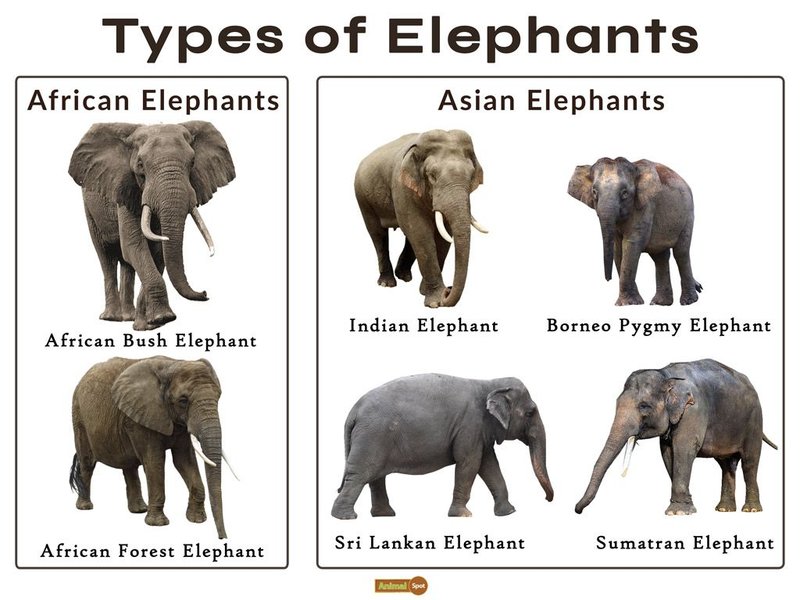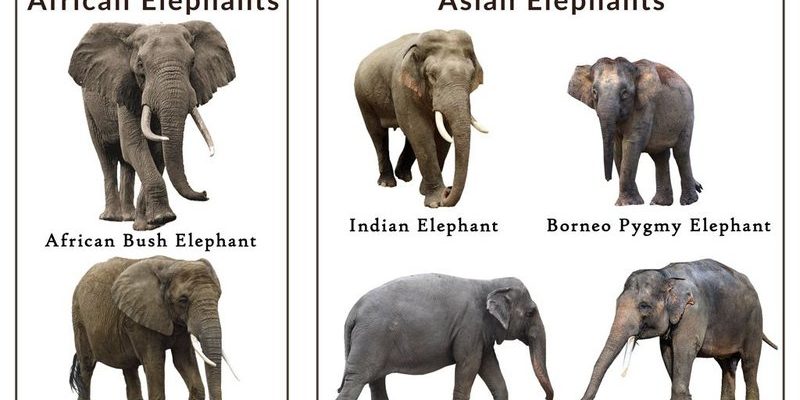
So, what makes the Indian elephant stand out, and how can we differentiate it from its lookalikes? Understanding these differences can be as intriguing as spotting a friend in a crowd. You might be wondering, “What traits should I be looking for?” or “How can I be sure I’m not mistaking one animal for another?” Let’s dive into the world of these similar creatures and get you equipped with fun facts so you can easily tell them apart!
1. African Elephant
Let’s start with the most obvious cousin of the Indian elephant: the African elephant. These giants are a bit different, though. African elephants are generally larger and have bigger ears that resemble the shape of the continent they come from. Think of it as them wearing a map on their head!
Here’s the key difference: African elephants have two “fingers” at the tip of their trunks, while Indian elephants only have one. This makes their trunk more flexible, great for grabbing branches or picking up small objects. This feature can help you identify them from a distance. So, if you see a massive trunk with some serious dexterity, you might just be looking at an African elephant!
2. Asian Elephant
You might be surprised to learn that the Indian elephant is actually a sub-species of the Asian elephant. They share many similarities, but don’t mistake them for the same animal. One significant difference lies in their size: Indian elephants tend to be slightly smaller than their other Asian counterparts from regions like Sri Lanka and Thailand.
Another thing to look out for is the dome-shaped head of the Indian elephant. It’s more pronounced compared to other Asian elephants, which typically have a more rounded skull. The presence of tusks is also a noteworthy difference; not all Indian elephants have tusks—and those that do, often have smaller ones compared to their Asian relatives.
3. Woolly Mammoth
Next up is the woolly mammoth—the closest relative of today’s elephants that roamed the earth thousands of years ago. While these creatures are extinct, they share similar features with the Indian elephant, like their tusks and trunk. Picture a hairy elephant adapted to cold climates; that’s your woolly mammoth!
The key distinguishing factor here is the thick coat of fur covering their bodies, which is something you won’t find on an Indian elephant. If you ever stumble upon a frozen mammoth in the Siberian tundra, its shaggy appearance will make it clear that it’s not just another cousin!
4. Mastodon
Similar to the woolly mammoth, the mastodon is an ancient relative that once walked the earth. They look like a mix between a modern-day elephant and a heavy-set hog. Interestingly, their teeth are the big giveaway. Mastodons had cone-shaped teeth designed for grinding leaves and branches, quite different from the flat molars of the Indian elephant.
While you might think a mastodon and an Indian elephant are similar at first glance, their stockier bodies and different dental structure make them stand apart. They lived during the same time period and even coexisted, so who knows if Indian elephants saw them as competition!
5. Hippopotamus
You might not think of the hippopotamus when talking about animals similar to elephants. However, they share a common ancestry, which is fascinating! Hippos have massive bodies and short legs, resembling the stocky shape of elephants from a distance.
One significant difference is their skin. Hippos are covered in smooth, hairless skin and spend a lot of time in the water to keep cool. Meanwhile, Indian elephants have rough, thick skin that helps protect them from the sun and insects. So, if you spot a hefty creature lounging in the water, it’s likely a hippo taking a soak!
6. Rhinoceros
Moving on to the rhinoceros, this animal’s size and stocky body can draw comparisons to elephants. Rhinos have large, hulking bodies and a tough exterior. Like elephants, they are herbivores and spend a good amount of time foraging for food.
But here’s the thing: the rhino’s distinguishing feature is its horn. Whether it’s a black rhino, white rhino, or Indian rhino, they all have that prominent horn on their snouts. Also, their skin is different; while elephant skin is more wrinkled, a rhino’s appearance is smoother. Spotting a horn is a quick way to tell these two animals apart!
7. Tapir
Meet the tapir, another animal that might surprise you. Tapirs have a stout body and short legs, somewhat resembling a mini version of an elephant. Their long snouts are quite flexible and can sometimes make them look like they’re wearing a trunk, just like elephants!
One way to tell a tapir apart is by observing its size. Adult tapirs are much smaller—about the size of a large dog. They also have a more rounded body and a distinctive pattern of spots on their skin. If you ever see a furry, snouty creature in the jungle, it’s probably a tapir, not an elephant!
8. Manatee
The gentle giant of the sea, the manatee, has a soft spot in my heart. With their large bodies and herbivorous diets, manatees and elephants share some fascinating similarities. Both are quite social and love to graze on plants, but here’s where the similarities start to fade.
Manatees live in water, while elephants are land dwellers. Their skin is smooth and more reminiscent of a whale than an elephant’s rough exterior. If you spot a large, gray animal floating lazily in warm waters, you can bet it’s a manatee, not an Indian elephant!
9. Capybara
The capybara is quite a leap from the hefty elephants we’ve been discussing. These creatures are considered the largest rodents in the world. While they’re tiny compared to the Indian elephant, they share a social, herd-like behavior that’s similar.
You won’t mistake a capybara for an elephant based on size alone. These fluffy, semi-aquatic critters hang out near water sources in groups. If you see a group of furry little creatures lounging by a river, you’re looking at capybaras enjoying a sunny day, not their elephant cousins.
10. Giant Anteater
Finally, let’s look at the giant anteater. At first glance, they might seem to have nothing in common with elephants, but their unique body shape can create visual similarities. Like elephants, giant anteaters have long bodies and strong limbs.
However, the most significant difference is their long snout and tongue, designed explicitly for slurping up ants and termites. They also have a distinct fur pattern that sets them apart. Encountering a giant anteater in the wild is like seeing a quirky cousin at a family gathering you didn’t expect!
In conclusion, while the Indian elephant stands as an impressive titan in the animal kingdom, it’s fascinating to consider the many creatures that share some traits with it. From the massive African elephant to the quirky giant anteater, each of these animals has its own unique features and behaviors.
By learning how to differentiate these animals, you not only deepen your appreciation for wildlife but also equip yourself with fun facts to share with friends and family. Remember, whether it’s the size, shape, or habitat, there’s always something interesting to discover about these beautiful creatures of our planet!

